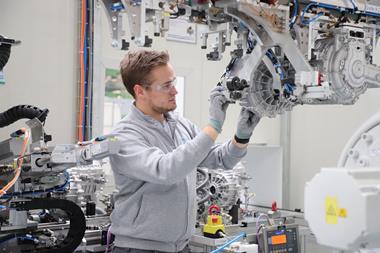
In-process measurement can guarantee fewer rejects, easier assembly, and ultimately, happier customers before a single part reaches the OEM
 The ‘where’ in automotive manufacturing has changed and expanded over time as OEMs rely further on increased content from Tier suppliers. From frames, closures, headlamps and tail lamps all the way to complete body assemblies: OEMs are pushing Tier suppliers to do more. OEMs and their customers are focused now, more than ever, on final vehicle appearance, performance, longevity and quality. As a result, Tier suppliers are expected to demonstrate their parts meet OEMs’ tight GD&T specifications. This is where 100% process inspection and extensive GD&T reporting capability are a must.
The ‘where’ in automotive manufacturing has changed and expanded over time as OEMs rely further on increased content from Tier suppliers. From frames, closures, headlamps and tail lamps all the way to complete body assemblies: OEMs are pushing Tier suppliers to do more. OEMs and their customers are focused now, more than ever, on final vehicle appearance, performance, longevity and quality. As a result, Tier suppliers are expected to demonstrate their parts meet OEMs’ tight GD&T specifications. This is where 100% process inspection and extensive GD&T reporting capability are a must.
To improve quality, OEMs tighten tolerances and reject more parts – all at great cost to the supplier. Standard checking fixtures and CMMs can perform measurements on a few parts but that measurement is costly and time consuming, especially if multiple units need to be measured to show process capability. Measurement quality, with check fixtures, can vary with the skill of the operator and the measurements from CMMs can be a long way, in time and distance, from the production process. This can result in longer lead times at the start of production and difficulty determining root causes when quality issues arise. It all comes down to overall manufacturing cost and data confidence for the Tier supplier and the OEM.
There is a profound difference between part inspection and process inspection and it has implications on manufacturing quality and cost. Inspecting parts tells the manufacturer the quality of what they already made but only on the parts measured. With this sampling strategy, a part out of tolerance can mean an entire batch of parts need to be quarantined and checked for compliance even if some of those parts are already on the OEM’s floor.
With 100% measurement the manufacturer knows the quality of each part. Measuring every part also provides the information to control the quality by improving the manufacturing process. Perceptron has been installing 100% in-process measurement since 1983. By taking measurements on every part and turning that raw data into actionable information, manufacturers can find and eliminate the causes of variation in critical product dimensions before a single part is shipped to the OEM. This results in launching sooner, less scrap, fewer rejects, easier assembly, lower cost, data protection, and happier customers.
A good quality control plan starts with the OEM identifying the critical features for each part and what inspection methodology should be used to provide the necessary data. By utilising the same Perceptron measurement solution and inspection plan at the Tier level and at the OEM, the quality transfer is seamless. A well-defined and implemented measurement strategy is beneficial to everyone. The Tier supplier can prove their capability sooner while understanding their part and process quality, and the OEM starts with a solid foundation supported by data they understand.
Act on data
It is said that “you can’t manage what you don’t measure” and similarly “what is measured improves” Perceptron certainly agrees with measurement for improvement, but it is not enough to measure every part and generate reams of data. It is critical that data is turned into information that can be acted upon. Perceptron systems have a fully integrated reporting package that enables root-cause analysis in real-time. Often it is not a single measurement characteristic that is critical but the relationship between many features that indicates a need for corrective action. A full suite of GD&T relationships allows the user to set intelligent tolerances and signal an ALS (Automatic Line Stop) condition.
Perceptron’s gauging platform enables GD&T reporting for parallelism, angularity, flatness, profile, true position, relative true position and more. Relative true position, sometimes called pattern true position, is when the pattern of attach points is critical later in the process when, for example, the alignment between an EV’s battery and the matching underbody attach points used to mount the battery. The ability to set a tighter tolerance on the pattern of holes and a less restrictive individual hole tolerance improves throughput while controlling and containing on the critical requirement of relationship between the holes.
GD&T is just one part of the overall reporting capability built into the software. Multiple unique identifiers, defined by the customer, can be transferred from the PLC and tagged with the part measurement data for quick process troubleshooting. It is not always a part quality problem. For example, the pallet used to move an underbody down the assembly line may be the problem. Each pallet has a unique ID, that ID is recorded for each underbody it held when measured. If a pin breaks, it is likely to go unnoticed until a routine visual inspection occurs at shift change, but the measurement data reflects the damage and flags the operator. With a few clicks in the reporting software, the pallet ID is identified and the damaged pallet is pulled from the line for repair.
Decades of knowledge
Perceptron has been assisting manufacturers improve their process and as a result improve their shipped product for decades.Product problems primarily come from three causes:1. Part location variation (geo-tooling)2. Variation in the component parts (forming process)3. Part-to-part interface (joining surfaces)Full measurement also enables and enhances a Tier 1 manufacturer’s Industry 4.0 implementation. While robots, PLCs and other electronic devices can tell you how many cycles they have run and to help predict failures, a tooling pin or weld tip has no such capability. In some OEM plants that have utilised 100% measurement for decades it is common to hear reject limits called ‘Tip Levels.”
Plant personnel know that when certain measurement points exceeded their limits it is time to change weld tips as the worn tips have started to impact quality. Perceptron systems have been providing this type of Industry 4.0 information via plant networks since the early 1990s. Today Industry 4.0 calls for information transparency and interoperability and Perceptron delivers with the ability to share their measurement data across the Tier’s manufacturing infrastructure all the way to the OEM’s quality data systems.
A holistic approach
To further automate and improve quality, robot guidance and automated assembly solutions are ideal for repetitive operations like welding, glue bead dispensing, de-racking, material handling as well as dangerous operations like lifting heavy panels or dispensing harsh materials. Since the same hardware and software are used, a single system can guide the robot to place a part and measure the part after it is placed. Perceptron’s guidance solutions measure the mating components and then offset the robot based on the very best possible fit given the limits of each parts’ build and position error. A quality measurement is then taken to verify the placement. It is another way to control the process and better utilise employees.
If it is dimensional gauging or robot guidance, Perceptron takes a holistic approach to manufacturing and how each station and operation influences the final product’s quality. Measurement locations strategically placed throughout the assembly line allow the manufacturer to proactively control their process and avoid no-build conditions. Equipment breaks and parts get damaged but those that measure 100% find and fix issues faster, at lower cost, leading to quicker launches and more consistent product.
































